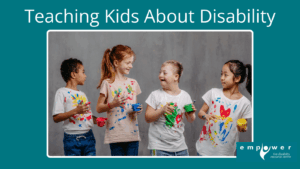Teaching Kids About Disability
September 7, 2025

It’s incredible important to start teaching our kids about disability! But how do we do that, especially if we don’t feel like a “disability expert” to begin with?
Start with finding common ground! Point out shared interests. Talk about common feelings. By finding shared qualities that our children have with a child with disabilities, it not only helps children bond and create friendships, it helps our kids see disabled people as individuals.
A second way to teach children about disability is to use inclusive language.
It is commonly suggested to use person-first language (“person with a disability” rather than “disabled person”) to show respect for the person – however many people with disabilities prefer identity-first language (“autistic person” rather than “person with autism”) – so we recommend to simply ask the person what they prefer, if possible.
It’s also important to avoid stereotypes, stigma and other ableist terminology. With kids, gently correcting misinformation or hurtful statements and teaching that these statements can cause someone to feel sad or excluded is a great way to not only help kids learn but to foster empathy and inclusion.
Another way to help kids learn about disability is to nurture empathy and curiosity.
Providing a safe space for kids to be interested and ask questions not only allows for disability education but lets them know that it is okay to be curious about difference.
Using books and media to tell positive and real stories about different people with disabilities can allow kids to learn about assistive devices, similarities and differences in daily life and interests they may share.
And finally, another great way to teach kids about disability is to promote kindness and inclusion.
Teach children not to point or stare at a person with disabilities and to use kind words when speaking to them. Encourage genuine friendship by teaching your child to ask before offering help to a disabled child – this teaches respect for the autonomy of the child with a disability.
And most importantly, as the adult, step in immediately if you see teasing, bullying or exclusion and let the child know that this behaviour is unacceptable!